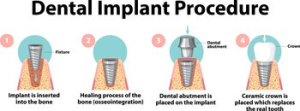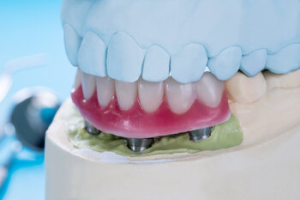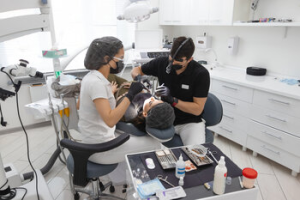The Comprehensive Guide to the Dental Implant Procedure

Dental implants have revolutionised the field of implant dentistry, offering a durable and reliable solution for those with missing teeth. But what exactly does the dental implant procedure involve? This comprehensive guide will break down every step, from initial consultation to recovery.
Understanding Dental Implants
Before diving into the dental implant procedure, it’s essential to understand what dental implants are. Essentially, a dental implant aims to act as a tooth root. Usually made from titanium, this metal implant is surgically inserted into the jaw bone, creating a strong base for the new artificial teeth or teeth.
Initial Consultation: Setting the Stage
The journey to getting dental implants begins with an initial consultation. Your dentist will review your dental history, ensuring you are a suitable candidate for the procedure. This is crucial because conditions like gum disease can compromise the success of dental implant surgery.
During this appointment, dental X-rays will be taken to assess the health of your jawbone. These X-rays will also help your dentist devise a precise treatment plan tailored to your needs, whether you’re replacing a single missing tooth or requiring multiple implants.
Bone Grafting: Laying a Solid Foundation
Not everyone has enough jawbone to support dental implants. Factors like gum disease, tooth decay, and even the natural process of bone loss after tooth extraction can leave the jawbone too weak or thin. If this is the case, bone grafting may be recommended.
Bone grafting is a surgical procedure where bone material is taken from another part of your body or a synthetic source and then added to your jawbone. This procedure ensures that the implant has a robust and stable foundation. The bone grafts will take several months to fuse with the existing bone, but this step is crucial for the success of the implant treatment.
Implant Placement: The Main Event
You’ll undergo dental implant surgery once your jawbone is ready (either naturally or post-bone grafting). During this surgical procedure, the dental implant is inserted into your jawbone. Local anaesthetic ensures that most patients experience only mild discomfort.
It’s crucial to note that the dental implant process does not provide the artificial tooth immediately. Instead, the metal implant is left in place to allow for a process known as osseointegration. This entails the fusion of the dental implant with the natural bone, creating a secure base for the new teeth.
The Healing Phase and Abutment Placement
Post-implant placement, there’s a healing phase that can last several months. During this time, the dental implant integrates fully with the jaw bone. Once the implant is securely fused, the next step is abutment placement. An abutment is a connector that will hold the new tooth or teeth.
The gums are reopened to expose the dental implant, and the abutment is attached. After this step, there’s another short healing phase to allow the gum tissue to settle around the abutment.
Choosing and Placing the Artificial Tooth
With the groundwork complete, it’s time for the crowning glory of the dental implant procedure: placing the artificial tooth. Depending on your specific needs, If you are getting a single dental implant, you may get a dental crown; if you need to replace several teeth, a dental bridge will be used.
The artificial teeth, whether a dental crown or dental bridge, are custom-made to match your real teeth’ colour, shape, and size, ensuring that your new smile looks as real as your own.
The Recovery Process

Like any surgical procedure, there’s a recovery process post-dental implant surgery. Most patients experience some mild pain, swelling, and bruising. The dentist may prescribe pain medications and antibiotics to manage discomfort and prevent infection.
It’s essential to follow a soft foods diet in the days immediately following the surgery. This protects the surgical site and ensures that the surrounding teeth and gum tissue aren’t under undue pressure.
Advantages of Dental Implants vs Other Tooth Replacement Options
While there are other teeth replacement options like dental bridges, dental implants offer several advantages:
- Natural Feel and Look: Dental implants mimic the feel and appearance of natural teeth, ensuring that your smile remains as authentic as possible.
- Durability: With proper maintenance, dental implants can last many years, if not a lifetime.
- Protects Bone Health: Implants prevent jaw bone loss, a common issue when you have missing teeth.
- No Impact on Surrounding Teeth: Dental implants stand on their own, unlike dental bridges, which require the reduction of adjacent teeth.
Maintaining Your Dental Implants
Once your dental implant procedure is complete and you have your new artificial teeth, it’s essential to care for them as you would your real teeth. Regular brushing, flossing, and dental check-ups will ensure your implants remain in top shape for years. Remember, while the implants are artificial, the surrounding gum tissue and other teeth are real and can still be prone to dental issues like gum disease and tooth decay.
Dental Implant Varieties: Beyond the Basic Procedure
When considering the dental implant procedure, it’s essential to know that dental implants aren’t one-size-fits-all. Various types of dental implants might be more suitable depending on an individual’s oral health, bone density, and specific needs.
- Endosteal Implants: These are the most commonly used type, typically made of titanium, and are shaped like small screws. They are placed directly into the jawbone, giving you a strong and stable foundation for the new tooth.
- Subperiosteal Implants: Positioned under the gum tissue but on or above the jawbone, subperiosteal implants are typically used for patients who lack enough healthy natural jawbone and don’t want to undergo a bone augmentation procedure to rebuild it.
- Zygomatic Implants: While it’s the least common type, this might be an option if there isn’t enough jawbone for the implant in the upper jaw. The implant is placed in the cheekbone (zygoma) instead.
Bone Augmentation Procedures
In cases where the jawbone isn’t thick enough or is too soft, you might require bone augmentation or a sinus lift procedure. This process involves adding bone or a bone-like material to the jaw.
- Sinus Lift: Sinus augmentation involves adding bone below the sinus, areas where natural bone deteriorates due to missing upper back teeth.
- Ridge Expansion: If the jaw isn’t wide enough for dental implants, bone graft material can be added to a small ridge or space at the top of the jaw.
Choosing Between Single and Multiple Dental Implants
The dental implant procedure varies depending on whether you’re replacing a single or multiple teeth.
- Single Tooth Replacement: This involves one implant and a crown, replacing both the lost natural tooth and its root.
- Multiple Teeth Replacement: If you have several missing teeth, you don’t necessarily need an implant for every missing tooth root. Instead, implant bridges or partial dentures can replace them.
Implant-Supported Crowns and Bridges
Losing a tooth or several teeth is not just a cosmetic issue; it’s also a functional concern. Traditional dental crowns and bridges have been used for decades to rectify such gaps. However, with advancements in dental technology, implant-supported crowns and bridges have become a game-changer.
What are Implant-Supported Crowns and Bridges?
As the name suggests, implant-supported crowns and bridges are dental prosthetics anchored securely to dental implants. Unlike regular bridges and crowns, which rely on adjacent natural teeth for support, these are directly mounted on implants surgically inserted into the jaw bone.
Implant-Supported Crowns and Bridges: The Procedure
While traditional dental crowns and bridges are fixed atop the natural teeth, implant-supported ones are anchored to dental implants. The procedure offers a sturdy solution for missing teeth.
Procedure Breakdown:
- Initial Consultation: A thorough dental X-ray is taken, often accompanied by 3D imaging, to analyse the patient’s jaw bone condition. This helps determine if any bone grafts are needed before the implant placement.
- Implant Placement: A dental implant, often made of titanium, is surgically inserted into the jawbone. This serves as the foundation for the crown or bridge.
- Healing Phase: Over several months, the implant fuses to the jawbone in a process known as osseointegration. This ensures the implant is securely integrated into the bone, providing a stable foundation.
- Attachment of Abutment: After the healing phase, an abutment, which serves as a connecting element, is fixed atop the implant.
- Placement of Crown or Bridge: Finally, the custom-made crown or bridge is fixed securely to the abutment, completing the restoration process.
Advantages:
- Preservation of Surrounding Teeth: Traditional bridges require reshaping the neighbouring teeth, whereas implant-supported bridges preserve and protect the surrounding teeth.
- Stability and Comfort: Implants fuse to the jaw bone, providing unparalleled stability. This means fewer chances of the bridge or crown becoming loose over time.
- Natural Appearance: Implant-supported prosthetics seamlessly blend in with other teeth, ensuring your smile remains natural and indistinguishable from real teeth.
- Improved Jawbone Health: Dental implants prevent jawbone loss, a common consequence of missing teeth. Over time, the bone remains healthier and more robust.
- Longevity: Given proper care, implant-supported crowns and bridges can last many years and, in most cases, a lifetime.
Digital Guided Implants
With the ever-evolving world of dentistry and medical technology, procedures have become more precise, less invasive, and more predictable. One such advancement is the use of digital guided implants.
Understanding Digital Guided Implants:
Digital-guided implant surgery involves utilising computer technology and 3D imaging to gather in-depth information about the patient’s jaw structure, nerve pathways, and dental and medical history. This data assists in planning the placement of dental implants with unprecedented accuracy.
Digital Guided Implants: The Procedure
Digital-guided implant technology has transformed dental implant procedures, emphasising precision and predictability.
Procedure Breakdown:
- Digital Imaging: The first step involves capturing comprehensive 3D images of the patient’s mouth. This provides a detailed view of the bone structure, tissue, and nerve pathways.
- Virtual Treatment Planning: Using specialised software, the dentist virtually plans the exact location, angle, and depth for the implant placement. This allows for a clear visualisation of the result before the procedure even begins.
- Creation of a Surgical Guide: A physical surgical guide is crafted based on the virtual treatment plan. This guide assists the dentist during surgery, ensuring the implant placement aligns perfectly with the digital plan.
- Implant Surgery: With the surgical guide, the dentist proceeds with the implant surgery. The guide ensures the implants are positioned per the digital treatment plan, minimising the chances of human error.
- Recovery and Final Restoration: As with traditional dental implant procedures, there’s a healing phase. Once healed, the artificial tooth or teeth are secured to the implants, bringing the patient’s smile to its optimal appearance and function.
Advantages:
- Precision: One of the most notable benefits is the enhanced accuracy. The surgical procedure is pre-planned down to the millimetre, ensuring the implant is placed in the optimal position.
- Safety: By visualising the internal structures of the jawbone, like nerve pathways, the risk of nerve damage or complications is significantly reduced.
- Minimal Invasion: With a clearer understanding of the patient’s anatomy, dentists can make smaller incisions, leading to quicker healing and reduced discomfort post-operation.
- Efficiency: The entire dental implant procedure becomes more streamlined. Often, patients spend less time in the chair, and the number of visits to the dental clinic might also be reduced.
- Improved Outcomes: Digital-guided implants offer more predictable results. The precise placement ensures the implant fuses better with the jawbone, leading to a higher success rate and longevity.
- Patient Comfort: With digital technology, patients can visualise the proposed outcome before the treatment begins. This often brings a sense of relief and confidence in the procedure.
Conclusion
The dental implant procedure is a transformative treatment that offers a durable solution to missing teeth. While the process is detailed and can span several months, the result is a natural-looking set of teeth that can last a lifetime. Dental implants are a game-changer for those looking to regain their smile and confidence.
If you’re considering dental implants, don’t hesitate to contact The Smile Workx. Our team is here to guide you every step of the way, ensuring you achieve the smile of your dreams.
Note: Any surgical or invasive procedure carries risks. Before proceeding, you should seek a second opinion from an appropriately qualified health practitioner.
References:
https://www.mayoclinic.org/tests-procedures/dental-implant-surgery/about/pac-20384622



